Ana Garbín Alonso: Identity of ‘anarchist Madonna’ revealed 87 years after iconic Spanish Civil War photo
The identity of the young militiawoman on a barricade in Barcelona had been a mystery until an exhibition in Montpellier of long-lost works by its author, Antoni Campañà

She was a nameless woman standing on a barricade in Barcelona in 1936, a red-and-black flag framed behind her. Her image was printed on posters and books, murals were painted of her, and she became an icon of the Spanish Civil War. Her identity was unknown, as was that of the photographer. Five years ago, the first enigma was solved: the photographer was Antoni Campañà, a recognized name but a minor one in the history of local photography. She remained anonymous: an almost abstract idea — of the Civil War, of anarchism, of revolution — rather than a flesh-and-blood person. Until now.
Because the anarchist militiawoman had a name and a life. She was born in Almería in 1915. As a child her parents moved to Barcelona. She was 21 years old at the time the photograph was taken. She may have been pregnant in the image. When the war ended, Franco’s Nationalists victorious, she crossed the border with her sisters during the Republican exodus of 1939 and ended up in Béziers, 130 kilometers (80 miles) from the French-Spanish border. She was a dressmaker. She never set foot in her homeland again, but her home was always a small Spain: the laughter, the songs, the food. She died in 1977.
Her name was Ana Garbín Alonso, and she was mother to Pepito and aunt to Alain and François. One midday in mid-June, in a conversation with EL PAÍS, these three very French, and at the same time very Spanish, retirees dug up memories of “mom,” “Aunt Anita” and her sisters — the mothers of Alain and François — while eating tortilla in the garden of the home shared by François and his wife, Liliana, in Sérignan, near Béziers. “She was very pretty, but one’s mother is always the prettiest,” smiled Pepito Lumbreras Garbín, the son of the militiawoman and José Lumbreras, a Spanish communist who fought in the Resistance. “She was nice and jovial, she liked to sing, to spend time with her friends and family.”
Pepito, Alain, François and Liliana oscillated between impatience and excitement. It was not long before the identity of the famous militiawoman would be revealed. It finally came to light on Tuesday in Montpellier with the inauguration of the exhibition Icônes cachées. Les images méconnues de la guerre d’Espagne (Hidden icons. The unknown images of the Spanish war).
The exhibition offers a selection of Campañà's work, discovered in 2018 by his grandson, Toni Monné, contained in two red boxes — thousands of photographs from the Civil War that Campañà preferred to keep hidden until his death in 1989, aged 83.
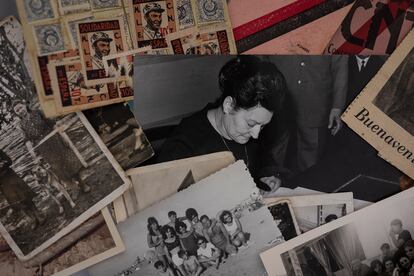
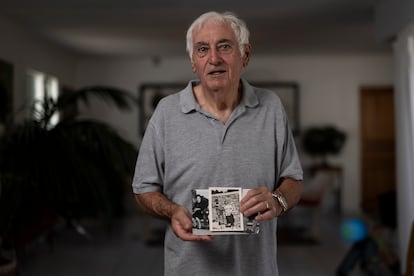
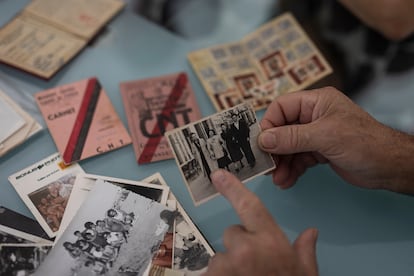
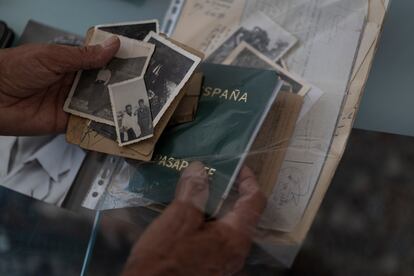
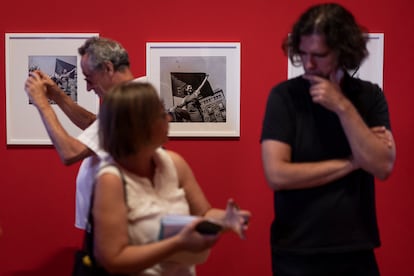
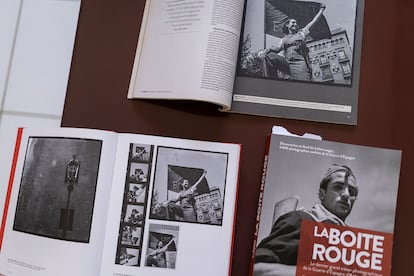
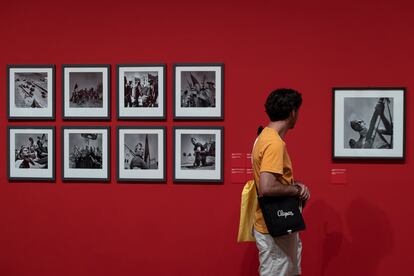
This is a story of chance encounters and coincidences. Monné discovered the boxes when the old family house in Sant Cugat was going to be demolished, a treasure trove that would change his grandfather’s place in the history of photography: until then he was known for his artistic images taken before the war, his sports photos from after the war and the tourist postcards he created during the years of Spanish developmentalism. The photos represented an extraordinary document of the Civil War — not an external view provided by foreign photojournalists, nor that of a photographer committed to a cause, but that of someone who documented what was happening during the war from the inside: a beautiful and terrible self-portrait of Barcelona. Campañà photographed refugees fleeing Franco’s repression as well as nuns, who had been murdered and burned.
The second turning point in the story came two years ago, when François Gómez Garbín, Anita’s nephew, and his wife Liliane Hoffman, visited Campañà's exhibition at the MNAC in Barcelona. There, they were greeted by the exhibition poster on the façade of the MNAC building. Aunt Anita!
“We got goose bumps,” recalls François. They had always known that the militiawoman on the anarchist posters and in the books about the Civil War was Anita, but no one else did. It so happened that at that moment, Toni Monné was also in the museum. “She’s my aunt,” the militiawoman’s nephew told the photographer’s grandson. “I couldn’t believe it,” Monné says. “It was a moment of shared emotion: the reunion between the photographer’s family and the family of the photographed.”
Before this, there was a first alignment of the planets: the moment the photograph was taken, July 25, 1936. The war has just broken out. The photographer was walking along La Rambla. At the corner of Hospital Street, he sees the militiawoman at the barricade. She sees him and poses; he trains his Robot camera on her and takes the photo. There is a brief misunderstanding: a young anarchist stops Campañà and accuses him of spying. Then he lets him go.
The boy is unaware that Antoni Campañà's encounter with Anita Garbín has just given birth to an iconic image of anarchism, what Garcia-Planas, in the catalog of the Montpellier exhibition, calls “the anarchist Madonna.” Nor does the young anarchist spot that there is something else that unites the bourgeois photographer — his appearance, his manners give him away — and the working-class militiawoman: they are both Catholics. Campañà belongs to a Catalan nationalist and orderly family, Garbín is the daughter of anarchists and, at the same time, a Christian.
“Sometimes I would go to church, to light a candle or pray for one or the other,” recalls Pepito. “She sent me to catechesis; it was part of the integration, we had to be like everyone else.”
And they did integrate. The cousins went into business. François met Liliane, the daughter of Holocaust survivors, in Paris. Alain spent some time in the capital, then returned to Béziers, where Pepito has always lived. But, like his cousins Alain and François, his heart was always in Spain.
“I always said, ‘I am Spanish,’” says Alain, who regained Spanish nationality a few years ago thanks to the 2007 Historical Memory Law. “Even if it’s a bit strange for anarchists, I was proud to vote for the first time in Spain — since 1936, with the Popular Front, a Garbín hadn’t voted in Spain!”
The after-dinner conversation progresses among memories and anecdotes, and some tears. They say that in Anita’s house they never talked about the Civil War. Pepito explains: “My mother, an anarchist. My father, a communist. It was a very sensitive conflict.” Anita and her husband did not return to their country. “They had made a cross over Spain,” says her son, who sprinkles the conversation with Spanish songs and recites the words to Juanito Valderrama’s song El emigrante: “Goodbye, my dear Spain / inside my soul I carry you tucked away.”
When a few years ago Anita’s sisters — François and Alain’s mothers — visited Barcelona, they spontaneously joined a demonstration in which CNT labor union flags were flying, as if something deep was calling them. “It was impulsive, without knowing why,” Alain says, his voice trembling.
They take out papers, old photos. Then Pepito takes us to the cemetery in Béziers. His mother is buried there, the anonymous militiawoman, anonymous no more: Anita Garbín Alonso, the anarchist Madonna. There are flowers on the grave. Her son crosses himself.
Sign up for our weekly newsletter to get more English-language news coverage from EL PAÍS USA Edition
Tu suscripción se está usando en otro dispositivo
¿Quieres añadir otro usuario a tu suscripción?
Si continúas leyendo en este dispositivo, no se podrá leer en el otro.
FlechaTu suscripción se está usando en otro dispositivo y solo puedes acceder a EL PAÍS desde un dispositivo a la vez.
Si quieres compartir tu cuenta, cambia tu suscripción a la modalidad Premium, así podrás añadir otro usuario. Cada uno accederá con su propia cuenta de email, lo que os permitirá personalizar vuestra experiencia en EL PAÍS.
¿Tienes una suscripción de empresa? Accede aquí para contratar más cuentas.
En el caso de no saber quién está usando tu cuenta, te recomendamos cambiar tu contraseña aquí.
Si decides continuar compartiendo tu cuenta, este mensaje se mostrará en tu dispositivo y en el de la otra persona que está usando tu cuenta de forma indefinida, afectando a tu experiencia de lectura. Puedes consultar aquí los términos y condiciones de la suscripción digital.
More information
Archived In
Últimas noticias
Tori Dunlap: ‘Talking about money is one of the most subversive things you can do’
Cartels in Mexico take a leap forward with narco-drones: ‘It is criminal groups that are leading the innovation race’
The Colombian who was imprisoned in El Salvador on Trump’s orders: ‘Being tortured for four months when you’re innocent is a nightmare’
North Korea, the latest stage in the Russian indoctrination of Ukrainian children
Most viewed
- The number of international tourists going to the US is decreasing, with one exception: Mexico
- A mountaineer, accused of manslaughter for the death of his partner during a climb: He silenced his phone and refused a helicopter rescue
- Belle da Costa, the woman who concealed her origins in 1905 and ended up running New York’s most legendary library
- Liset Menéndez de la Prida, neuroscientist: ‘It’s not normal to constantly seek pleasure; it’s important to be bored, to be calm’
- An interstellar traveler is getting closer to Earth than ever before: How to observe comet 3I/ATLAS









































